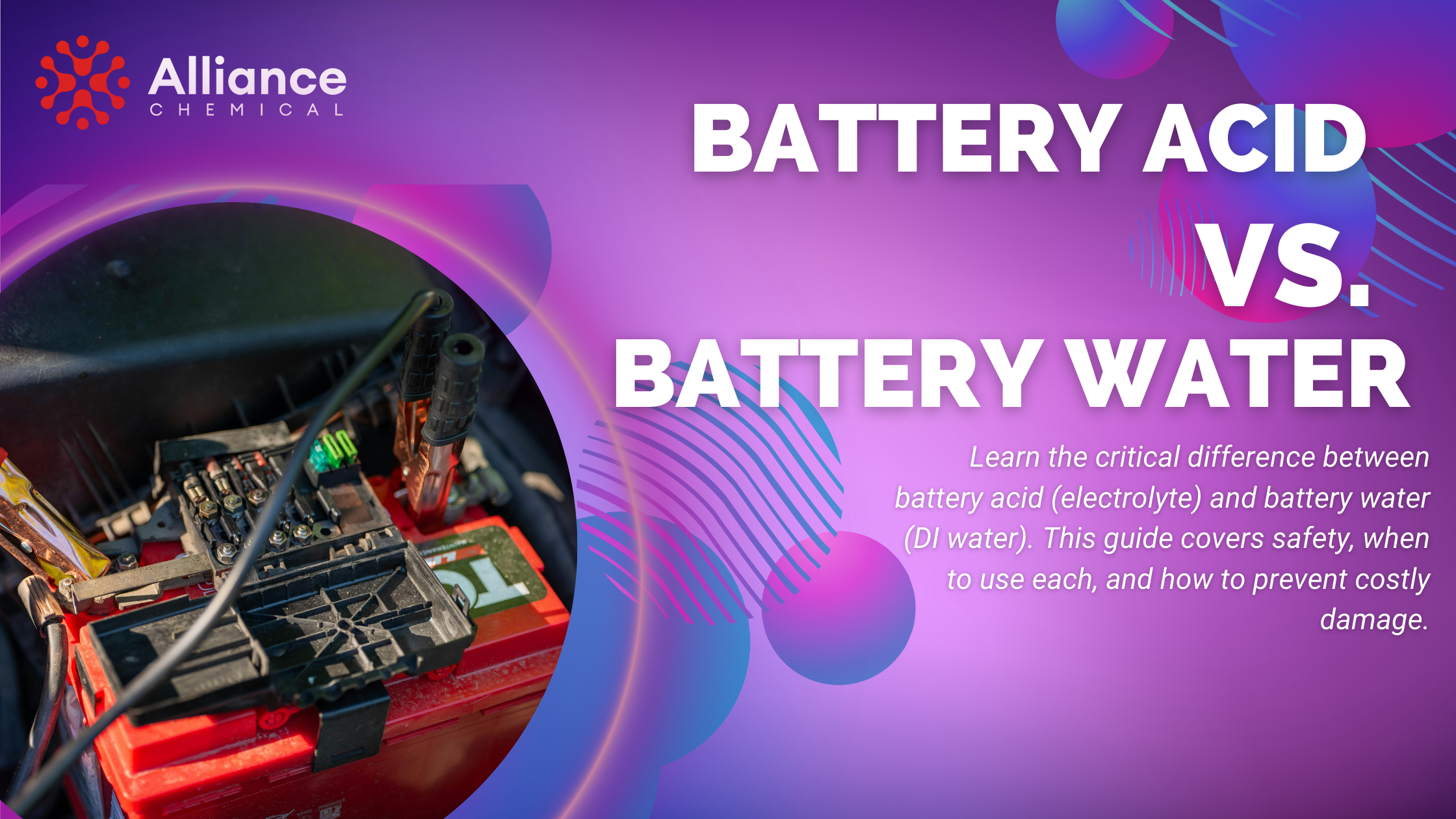
Battery Acid vs. Battery Water: A Complete Guide for Plant & Fleet Managers
What you will learn
"Just top it off with acid" is some of the most dangerous advice in any maintenance shop. This definitive guide for fleet and facility managers ends the confusion between Battery Acid and Battery Water once and for all. We do a deep dive into the science of why batteries only lose water, explain the catastrophic results of adding acid to an in-service battery, and provide a step-by-step playbook for safely checking and filling your batteries to maximize their lifespan. This is a must-read for ensuring the safety, reliability, and longevity of your entire lead-acid battery fleet.
📋 What You'll Learn
This guide walks you through battery acid vs. battery water: a complete guide for plant & fleet managers with detailed instructions.
Stop the #1 maintenance mistake: topping with acid. Learn exactly when to use electrolyte vs. deionized water, how to fill correctly, and the safety steps that protect people and assets.
The Most Dangerous Advice in the Maintenance Shop
In one plant visit, I heard a veteran tell a new tech, “If the battery’s low, add a little acid for a boost.” That tip ruins batteries and risks injuries. The confusion between Battery Acid (electrolyte) and Battery Water (deionized water) is common—but getting it right is the difference between a reliable fleet and a line of dying batteries.
The Fundamentals: Electrolyte vs. Pure Water
What is Battery Acid? (Electrolyte)
“Battery acid” is the electrolyte: a precisely mixed solution of sulfuric acid in water. For common flooded lead-acid batteries, the fully charged electrolyte has a specific gravity around ~1.265 at 25 °C. The acid enables the electrochemical reaction with the lead plates. Electrolyte is used to fill a brand-new, dry-charged battery before first use—then sealed for service. For supply, see: Sulfuric Acid 37% (Battery Acid).
What is Battery Water? (Deionized Water)
Battery Water is simply deionized (DI) water used to replace water lost during normal operation. Never use tap water: dissolved minerals and ions contaminate plates and separators, raising internal resistance and reducing capacity. Use only high-purity water: Alliance Chemical DI Water.
| Fluid | What it is | When to use | Never use for |
|---|---|---|---|
| Battery Acid (Electrolyte) | Sulfuric acid in water, SG ~1.265 when fully charged | Initial fill of a new, dry-charged battery only | Topping off any in-service battery |
| Battery Water (DI) | Deionized, mineral-free water | Routine topping off of in-service batteries after charge/cooldown | Initial electrolyte fill |
The Science of Water Loss: Why the Acid Stays
Two normal processes remove water from a battery; neither removes sulfuric acid:
1) Electrolysis (During Charging)
Charging splits H2O into hydrogen (H2) and oxygen (O2) gas, which vent out. Sulfuric acid remains in solution—so concentration creeps up if you don’t replace the water.
2) Evaporation (From Heat)
Heat during use/charge evaporates water. Sulfuric acid has a much higher boiling point and does not evaporate alongside the water.

Electrolyte loses water through gassing and heat; the sulfuric acid remains.
The Golden Rule of Battery Maintenance
NEVER top off an in-service battery with acid. Only water is lost during use and charging. Adding acid over-concentrates the electrolyte, accelerates plate corrosion, drives heat (thermal runaway), and permanently shortens battery life.
The Playbook: How to Check & Fill Safely
Correct level maintenance is the single most effective life-extender for flooded lead-acid batteries.

Use proper PPE, then add DI water until just above the plates—don’t overfill.
- Gear Up: Wear chemical splash goggles (or face shield over safety glasses) and acid-resistant gloves. Consider apron/sleeves.
- Ventilate & De-spark: Charging can emit hydrogen. Work in a well-ventilated area away from ignition sources.
- Clean the Top: Wipe the lid before opening caps so debris can’t fall into cells.
- Charge First: Charge fully, allow a short cooldown, then open caps. Electrolyte expands when hot—filling cold risks overflow later.
- Check Levels: Liquid should just cover the plates. If below plate tops, topping off is required.
- Add DI Water Only: Slowly add deionized water to each cell to about ¼–½" (6–12 mm) above the plates.
- Secure & Wipe: Re-seal caps, wipe any residual, and rinse exterior with water if needed.
- Record: Log date, operator, and any anomalies (e.g., frequent low cells).
Quick Checklist
- PPE on: splash goggles/face shield + acid-resistant gloves
- Charge → cool → then open caps
- Clean lid before opening
- Add DI water only to ¼–½" above plates
- Secure caps; wipe residue; log service
Spill Neutralization: The A-B-C Approach
- Always Be Cautious: Keep people clear; put on PPE.
- Contain: Dike with inert absorbent (clay or vermiculite).
- Neutralize: Sprinkle a weak base like Soda Ash (Sodium Carbonate) from the outside inward slowly until fizzing stops.
- Clean Up: Collect neutralized residue and dispose per local regulations.
Battery Water FAQ
Can I use tap water in a pinch?
No. Minerals/ions contaminate plates and separators, increasing internal resistance and reducing capacity. Use high-purity DI water only.
Why did specific gravity go up after I added acid?
You concentrated the electrolyte. Over-concentration accelerates plate corrosion and heat. For routine topping off, add DI water only.
When is battery acid actually used?
For the first fill of a brand-new, dry-charged battery—never for routine maintenance of in-service batteries.
How high should I fill the cells?
After a full charge and brief cooldown, fill to about ¼–½" above the plates. Overfilling causes hot overflow during charge.
Do sealed AGM/Gel batteries need water?
No. AGM and Gel batteries are sealed and maintenance-free. Do not open or add water/acid.
Get the Right Fluid for the Job
Using the correct fluid is the fastest way to extend battery life, reduce heat, and avoid costly downtime. Alliance Chemical supplies professional-grade, high-purity products trusted by fleets and facilities nationwide.







